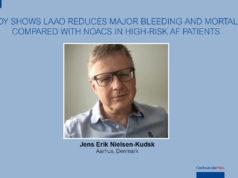
The FABOLUS FASTER trial, which was presented at PCR e-Course 2020 and simultaneously published in Circulation, shows that cangrelor provides inferior inhibitor of platelet aggregation (IPA) to tirofiban in ST-segment elevation myocardial infarction (STEMI) patients undergoing primary percutaneous coronary intervention (PCI). However, the study also shows that both treatment strategies provide superior IPA to compared with chewed prasugrel.
Writing in Circulation, Giuseppe Gargiulo (Department of Cardiology, Bern University Hospital, Bern, Switzerland) and colleagues report antithrombotic therapy “mitigates the ischaemic risks in STEMI patients undergoing primary PCI”. They add that new-generation P2Y12 inhibitors, such as prasugrel, are currently recommended “but their administration does not abrogate high residual platelet activity up to four to six hours loading dose”. Thus, strategies–such as crushing or chewing tablets—to increase the bioavailability of these oral agents have been investigated but data remain limited. Furthermore, parenteral agents, including cangrelor and tirofiban, have been shown to provide more rapid and sustained IPA compared with prasugrel or ticagrelor. The aim of FABOLUS FASTER, therefore, was to compare the pharmacodynamics of cangrelor vs. those of tirofiban (which have not been directly compared before) and integral prasugrel vs. chewed prasugrel.
In the study, STEMI patients were randomised to cangrelor (40), tirofiban (40), or prasugrel (42). Those randomised to prasugrel were further randomised to chewed (21) or integral (21) tablet administration. The primary endpoint was the 30-minute IPA at light transmittance aggregometry in response to 20µmol/L adenosine diphosphate.
At 30 minutes after administration, according to Gargiulo et al, tirofiban yielded superior IPA to cangrelor—meaning that the latter did not satisfy the trial’s criteria for non-inferiority to the former: 34.1±22.5 for cangrelor vs. 95±8.9 for tirofiban (p<0.001). However, both these of treatments were superior to prasugrel (IPA 10.5±11; p<0.001 for both comparisons). Of note, chewed prasugrel was not associated with superior IPA to integral IPA (6.3±11.4; p=0.47 for the between prasugrel comparison). Gargiulo et al observed that the “lower than expected” IPA with cangrelor occurred “throughout the entire study duration as well as to prasugrel at three hours or four to six hours after drug administration”. “This latter finding likely reflects the fast recovery of platelet function at the end of cangrelor infusion and the time needed for prasugrel to provide sufficient IPA once cangrelor infusion is terminated,” they add.

Presenting the data at PCR e-Course, Marco Valgimigli (Cardiocentro Ticino, Lugano and Department of Cardiology, Bern University Hospital, Bern, Switzerland) summarised: “Among STEMI patients undergoing primary PCI, cangrelor provided inferior IPA compared with tirofiban. Both parenteral strategies yielded superior IPA during drug infusion compared with chewed prasugrel. Chewed prasugrel, despite achieving early higher active metabolite concentrations, did not lead to greater IPA compared with integral prasugrel.”
He told Cardiovascular News: “The results of our study carry multiple implications for clinical practice. The potency of cangrelor among STEMI patients is surprisingly low and roughly three-fold lower than that provided by the on label regimen of tirofiban. This means that in patients with high thrombus burden, tirofiban is more suited to provide a full antithrombotic activity than cangrelor, which unlike tirofiban, is not associated with a rebound in platelet reactivity after drug infusion discontinuation. The second take-home message is that chewing standard loading dose of prasugrel is associated with a marginal and not significant increase in platelet inhibition, which is unlikely to translate into a clinically meaningful difference. Therefore, the final message from the study is that only parenteral agents are able to provide early inhibition of platelet reactivity among STEMI patients and yet the various antiplatelet parenteral options should not be seen as class agents considering that their potency and efficacy largely differ.”










